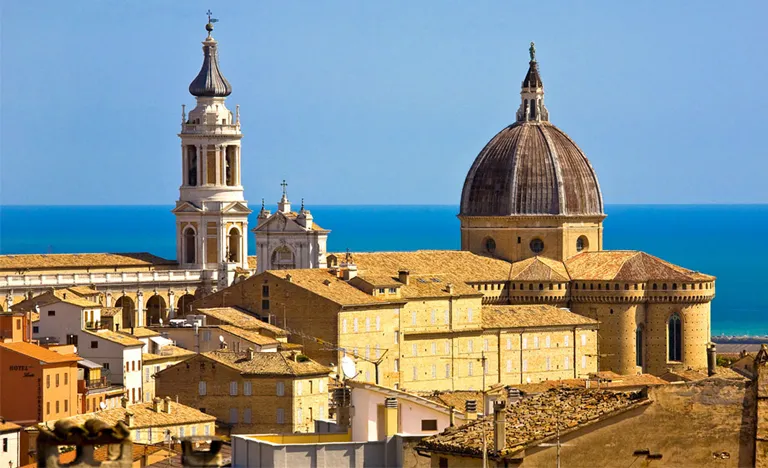
Introduction
The Sanctuary of the Holy House of Loreto, Italy / Our Lady of Loreto & The Holy House of Loreto – Basilica della Santa Casa is a Catholic place of pilgrimage in Loreto, Italy, containing the house in which the Virgin Mary lived.
The Holy House of Our Lady of Loreto is “a rest for the soul”, a place to meet God, and sometimes the inspiring reason and source of strength for new enterprises. A symbolic place of Christianity and home to the Holy House of Nazareth where Mary was born. A destination for pilgrims and art lovers.
It is the third largest shrine to Mary in Europe, next to Lourdes and Fatima. The ministry of the shrine is the hospitality shown to pilgrims especially through the sacrament of penance. The splendid City of Loreto, tucked inside the countryside of the Marches Region, owes its fame to the Sanctuary where the Santa Casa della Vergine Maria (Shrine of the Holy House of the Virgin Mary) is preserved and venerated. It is a holy place defined by Pope John Paul II as “the true Marian heart of Christianity.”
The sanctuary has been one of the most important pilgrimage sites for the Catholic faith for centuries, having been visited by approximately 200 saints and beatified persons, as well as by numerous Popes. According to ancient tradition, and today substantiated by historical and archaeological research, the Santa Casa is the house from Nazareth where the Virgin Mary was born, educated, and where she received the Annunciation. The house was composed of one room in masonry, with three walls in stone placed so as to enclose a rock cavern.
This cavern is worshipped by pilgrims who flock to Nazareth, that is to the Basilica of the Annunciation, while the three stone walls, as legend has it, were brought to Italy (first passing through Illyria) by crusaders expelled from Palestine in 1291. The walls arrived in Loreto in 1294. Not only, but documents and archaeological excavations have continued to reinforce the hypothesis that the walls of the Santa Casa were transported to Loreto by ship, an initiative undertaken by the Angeli Family, nobles who ruled over Epirus at the time.
The sanctuary (Santuario della Santa Casa) consists of the basilica of Saint Maria, beneath the dome of which is situated the Santa Casa, the Holy House of the Virgin, encased within a structure designed by Bramante in 1509. The birthplace of the Virgin in Nazareth was popularly believed to have been rescued from infidels by angels, who transported finally to its present location in December 1295.
The basilica of Our Lady of the Holy House of Loreto is a Late Gothic structure continued by Giuliano da Maiano, Giuliano da Sangallo and Bramante. The façade of the church was erected under Sixtus V, who fortified Loreto and gave it the privileges of a town (1586). The main entrance doors (1590-1610) to the church were cast in bronze by Antonio Lombardi and his sons; the doors depict scenes from the Old and New Testaments. The interior of the basilica is lavishly decorated. The earliest work was carried out by Luca Signorelli and Melozzo da Forlì.
History of Our Lady of the Holy House of Loreto
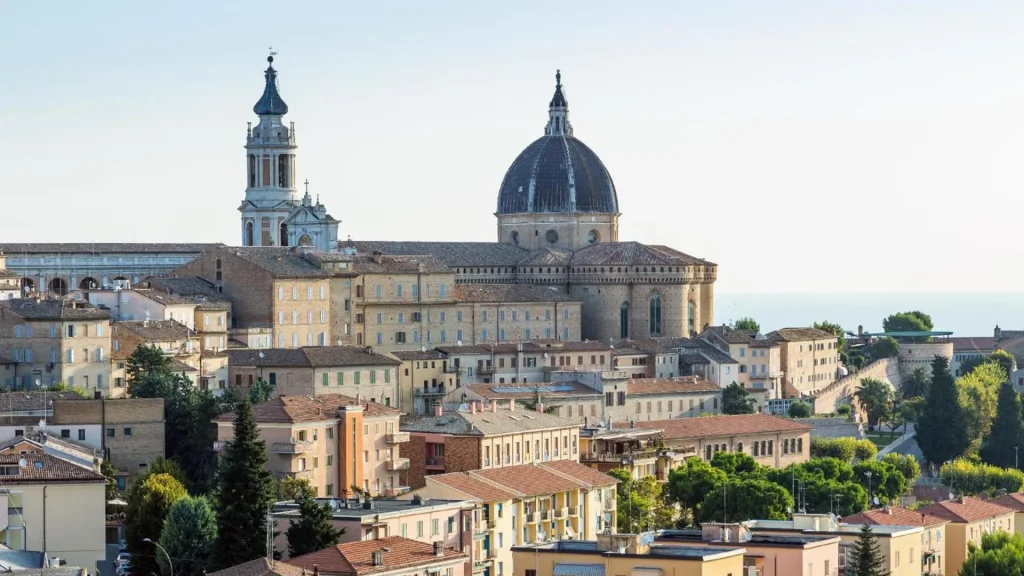
Indeed, one document dating back to 1294, testifies that Niceforo Angeli, despot of Epirus, in offering his daughter Ithamar’s hand in marriage to Philip of Taranto (son of the King of Naples, Charles II of Anjou), gave the Prince a dowry that included such treasures as the “holy stones taken from the Home of our Lady the Virgin Mother of God.”
In order to protect these humble stone walls, and to receive the ever-larger masses of pilgrims visiting the sacred relic, construction works on the magnificent Sanctuary of Loreto were begun in the mid-15th Century. Some of the most prized works here are the marble paneling of the Santa Casa’s walls, commissioned by Julius II and realized on Bramante’s design from 1507.
It is considered one of the greatest sculptural masterpieces from the Renaissance. Since its beginnings, great artists have adorned the Sanctuary one after the other through the centuries: from Cristoforo Roncalli (so-called Pomarancio), painter of the Treasury Room and the cupola; to Francesco Selva, who decorated the Sacristy Atrium; and Tiburzio Vergelli, architect of the majestic Baptistry. As a result, the sanctuary’s fame diffused rapidly throughout the world, and it became a privileged destination for millions of pilgrims.
As the works drew to their conclusion, then, it was Carlo Maderno who created the fountain in the Piazza del Santuario (1600), while the feat of the bell tower on the Basilica’s left side is attributed to Luigi Vanvitelli (1700). The entire City of Loreto, immersed in the tranquility of the Marches’s quiet rolling hills, rose up around the Sanctuary della Santa Casa, constructed on a hill that offers a spectacular panorama touching both the sea near Monte Conero and the Umbro-Marches Apennine Mountain Chain.
Today Loreto beckons to thousands of tourists – not just Catholics – for its grandiosity as a trove containing invaluable treasures. Besides the importance of the Santa Casa as object of pilgrim devotion, this site represents an authentic sacred art anthology that includes architectonic, sculptural, and painting master works by some of the most celebrated names in art history.
The Holy House itself is quite small, and its single room with a small altar contains a Black Madonna statue and a blue ceiling with golden stars. In 1469, a large Basilica was built over the Holy House. Having been remodeled and reconstructed numerous times over the ensuing centuries, the Basilica has a Renaissance exterior and a Gothic interior. In 1510 the Santa Casa was approved for pilgrimages, soon became extremely popular in Italy, and by the 16th century was receiving pilgrims from all over Europe.
Surrounding the Holy House, and inside the Basilica, is a marble concourse which pilgrims use to circumambulate the shrine. The pilgrims will kneel to make their way around the shrine and the millions who have done this devotional act have worn two shallow troughs with their knees in the hard stone.
And the beautiful, charming borgo that developed around the Basilica offers remarkably-evocative vistas, externally and internally, e.g. the Museum-Painting Gallery in Piazza del Santuario featuring canvases by masterful Venetian painter Lorenzo Lotto. Thus, Loreto equals pilgrimage site, tourist locality and gracious city of art set amidst gorgeous scenery. Finally, worth noting is the Macerata-Loreto Pilgrimage, in existence since 1978 (when John Paul II became Pope): on this route thousands of pilgrims travel on foot every year, from Macerata to Loreto’s Sanctuary.
Approximately half of the pilgrims originate from the Region of The Marches itself – the rest arrive in Macerata from all over Italy and various parts of Europe (particularly Belgium, Spain, Portugal, the republics of the former Yugoslavia, as well as Albania, Switzerland, and Germany). An ancient tradition tells that the walls of the Shrine existed in Nazareth, Galilea: the Holy House is the same House where Our Lady Mary was born, grew up and received the angelic announcement.
This tradition, based on devotion and popular belief, ascribed the transportation of the House of Nazareth to an angelic mission; current historical studies have developed the hypothesis of transportation carried out by Man, through sea and land, that came true with special assistance from above. That’s the way “to read between the lines” and give the most probable explanation to the Holy House event.
The Black Madonna of Our Lady of Loreto
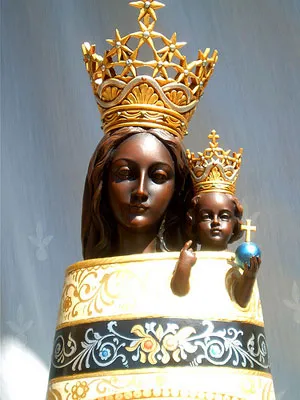
The title Our Lady of Loreto refers to the Holy House of Loreto, the house in which Mary was born, and where the Annunciation occurred, and to an ancient statue of Our Lady which is found there. Tradition says that a band of angels scooped up the little house from the Holy Land, and transported it first to Tersato, Dalmatia in 1291, then Recanati, Italy in 1294, and finally to Loreto, Italy where it has been for centuries.
It was this flight that led to her patronage of people involved in aviation, and the long life of the house that has led to the patronage of builders, construction workers, etc. It is the first shrine of international renown dedicated to the Blessed Virgin, and has been known as a Marian center for centuries. Popes have always held the Shrine of Loreto in special esteem, and it is under their direct authority and protection.
A niche contains a 33 inches high image of the Virgin and Child richly adorned with jewels, is above the altar. The statue was commissioned after a fire in the Santa Casa in 1921 destroyed the original Madonna, and it was granted a Canonical Coronation in 1922 by Pope Pius XI.
A legend attributes the original statue of olive wood to Saint Luke, but the style suggests it was created in the 15th century. The original statue, dating back to the 1400s, was an image of the Black Madonna with the Christ Child, both of whom were covered since the 16th century with a jeweled mantle or dalmatic.
The statue was stolen by Napoleonic troops in 1797 and taken to Paris. It was returned with the Treaty of Tolentino and ended up in Rome, from where the image made an eight-day journey as a pilgrim Madonna, arriving in Loreto on 9 December 1801. During the absence of the original statue from the Holy House, a copy made of poplar wood was placed in the niche and remains the only copy to have been venerated in the Holy House. This copy is now enshrined at the Chiesa della Buona Morte in Cannara.
In 1921, a fire broke out inside the Holy House which incinerated the sculpture. At the behest of Pope Pius XI, a new image similar to the original was immediately carved, using the wood of a cedar of Lebanon from the Vatican Gardens. It was modeled by Enrico Quattrini and executed and painted by Leopoldo Celani. In 1922, the statue was crowned in St. Peter’s Basilica in the Vatican and solemnly transported to Loreto.
There is a local tradition in the city of Treia that the original statue of Our Lady of Loreto was hidden and replaced with a copy before Napoleon’s troops looted the basilica. When the copy was returned to Loreto, the exchange with the original statue never took place. Thus, it was the copy that was destroyed by fire. The original statue was hidden in a convent and then taken by Visitandine nuns to Treia, where it is enshrined at the Church of Santa Chiara. Much like the Holy House, it is associated with miracles.
History of Our Lady of Loreto
This title of Mary refers to the house in which she was born and raised, and in which the angel Gabriel visited her in the Annunciation. Tradition holds that angels miraculously transported the house from Palestine to Loreto, Italy, in the 13th century.
It is now believed that this legend came from the fact that a patron family with the name “Angelo” either had the house moved or had stones for a replica home imported from the Holy Land. The stones in the shrine in Italy match the stones of a structure that still stands in Nazareth that is believed to be another part of Mary’s home.
The history that we have for the house—legendary or factual—states that after Jesus’ ascension, the apostles had the home converted to a church. During her pilgrimage to the Holy Land in 336, the Empress Helen had a large basilica built over it. At the close of the Crusades, European forces feared that the house would be destroyed, and it was moved. Miracles attended it wherever it went, and the house finally rested in Italy. A basilica encases the home once again, and the town of Loreto has grown around the shrine.
Just before opening the Second Vatican Council in 1962, Pope John XXIII made a pilgrimage to Loreto. Fifty years later, in 2012, Pope Benedict XVI made a second pilgrimage to the site to mark the anniversary of the council and to dedicate the Year of Faith to Our Lady of Loreto.
A portion of Mary’s house is kept in the reliquary chapel in the Basilica on campus, and the campus church for St. Mary’s College is named after Our Lady of Loreto. Because of the legend of the angelic flying house, Our Lady of Loreto is patron of airplane pilots and attendants, and of those serving in the Air Force. She is also patron of construction workers.
Our Lady of Loreto, who teaches us to make a home for Jesus in the world, pray for us!
The Black Madonna
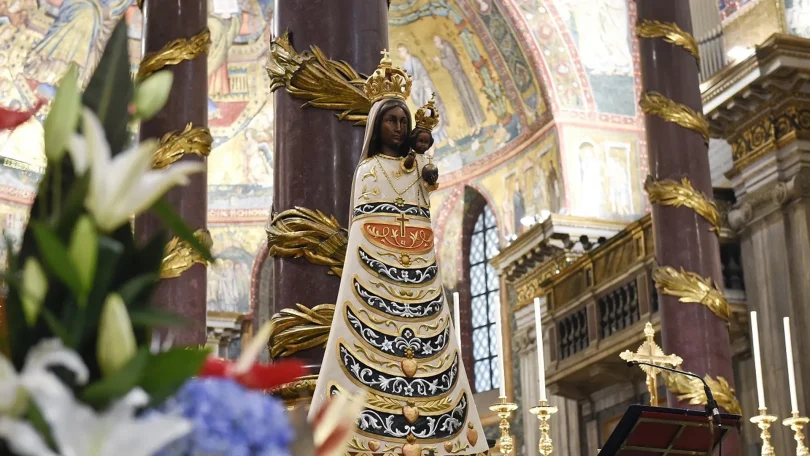
The reason why Our Lady of Loreto statue is black according to religion is due to the fact that it is mentioned in the “Song of Songs” where it reads: “Brunette are, but beautiful.” To reinforce this hypothesis is another phrase, always in the same song, which Mary says to her friends: “Do not look to me that I am brunette because I have sunburned me”. The Sun, which is also God’s figure, would be the origin of the phenomenon that characterizes not only the Madonna of Loreto, but also that of Czestochowa, which are women of white race but of black leather.
Our Lady of Loreto Black for Centuries of Lamp Smoke
When the walls of the Holy House were transported from Nazareth to Loreto, the faithful initially worshiped a painted icon on the table: it was a sweet and beautiful painting with a little black face. Some scholars have found that many sacred images in the past became dark and sometimes unrecognizable for cigar and lamp smoke so much that it was often necessary to redraw them. Most likely the same fate happened to the beautiful icon of the Holy House.
At the beginning of the sixteenth century the icon was replaced by a softly painted wooden spruce statue. Later on, the oil lamps that over the centuries illuminated the little house of the Holy House also blackened the outer marble of the sachets indefinitely.
Dark Wooden Statue
The smoke that the wooden statue of the Our Lady of Loreto (carved from Cedar of Lebanon) absorbed over the centuries has given it a very dark tint. In addition, despite the fact that the statue was destroyed in the 1921 fire and was rebuilt in 1922, on the Quattrini model, by L. Celani, it was made of Lebanon cedar wood painted uniformly and with a still black tone Darker than the previous one. Still today as tradition is done in 1924, on December 10, remembering the arrival of Santa Casa in Loreto, the fires are lit over the night to remember that happening.
The Three Walls of the Holy House
The original nucleus of the Holy House of Our Lady of Loreto consists of three walls only in Nazareth, the original fourth wall was simply the side opened towards the entrance of the grotto. On this edge now stands the interior altar of the Holy House of Our Lady of Loreto.
The Holy Chamber can be clearly defined in two different parts. The lower section (from the ground up to almost 3 meters in height) is the original wall, made with sandstone blocks, built-in regular rows, as we could find in Nazareth; the upper section is added afterward with Marche local brick, the only building material used in the area with those methods of construction.
A graffito on the wall of the Holy House
The technique used for the external finish of some stones is similar to that employed by the Nabateans and was very popular in Palestine during the Roman empire.
About sixty graffiti have been found, and most are considered by experts to be similar to those of the Judeo-Christians in the Holy Land, including Nazareth, belonging to ancient times.
The Marble Screen
The Marble Screen was commissioned by Julius II, who sent Donato Bramante to Loreto in 1507 to do “great things” there and to “draw many works”.
The opera was realized under the direction of Andrea Sansovino (1513-27), Ranieri Nerucci, and Antonio da Sangallo il Giovane. The statues of the Sybils and of the Prophets were inserted in their niches in a later period.
The Marble Screen consists of a podium with geometrical ornamentations, with a series of aligned columns articulated in two sections, crowned by Corinthian capitals supporting a projecting cornice. The balustrade, by Antonio da Sangallo, cloaks the ungainly barrel vault of the Holy House and also provides an elegant frame encasing the marvelous edifice.
Museum-Art gallery
It hosts some wooden models of the Basilica, which are very helpful to understand the architectural phases of its building. It’s possible to visit all 22 rooms of the Museum; the exhibition includes some detached frescos, too.
Outstanding among the various objects are some estimable canvases by Lorenzo Lotto, a fine collection of Renaissance ceramics, and 10 Raphaelesque tapestries. The collection of ancient apothecary pottery of the Holy House, considered one of the finest of the genre, is made up of a core group of 350 specimens, coming from the Orazio Fontana workshop.
Patrol walk away
It was built as a defense for the Shrine against the attacks of the Turkish fleet that sailed on the Adriatic sea. It’s a symbol of the strong military attention carried on by different Popes (Sisto IV, Giulio II Della Rovere, and Leone X de’ Medici) to protect the Holy House.
The building of this huge “Basilica-Fortress” attracted several of the greatest architects such as Baccio Pontelli, Donato Bramante, Antonio da Sangallo, and Cristoforo Resse.
Their work clearly shows the evolution of military defense based on the new fire weapons; the medieval war was over, the modern war started and this was assumed by a different pattern of edification.
During the Middle Ages, the medieval religious belief in Indulgences had a significant role in sponsoring pilgrimages to the holy shrines. For each day spent at the shrine of Loreto, pilgrims believed they were granted a reduction of punishment for their sins. The shrine of Loreto also attracted pilgrims because of the many stories of miraculous healing that occurred over the centuries.
Feast Day – 10th December
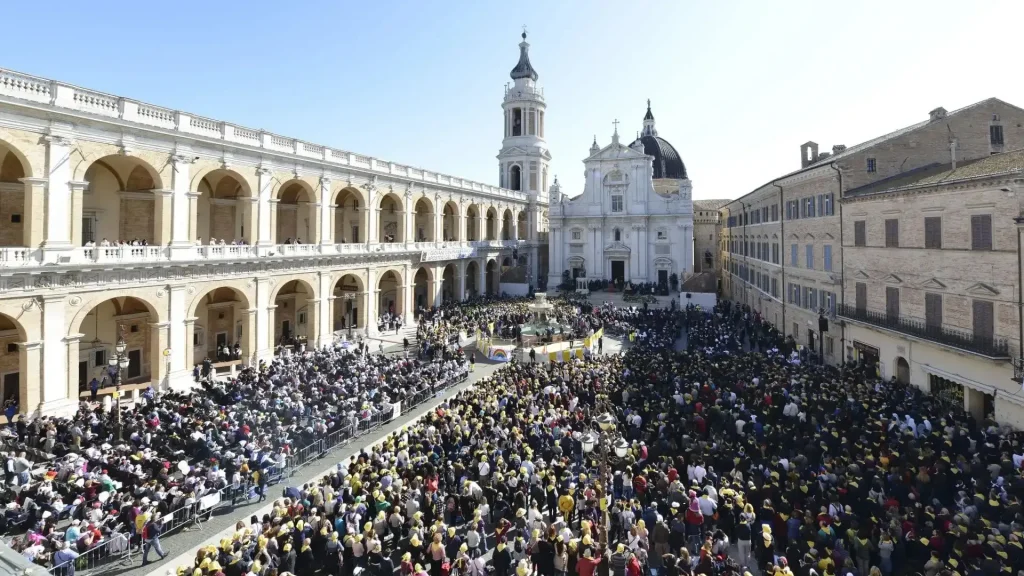
In 1920, the Virgin of Loreto became the patroness of pilots because of the legendary transport of the Santa Casa by angels. Each year, on September 8, the birth of the Virgin Mary, groups of pilots gather at the shrine to celebrate, to pray and give thanks for safe air flights, and to participate in a colorful procession. A statuette of Mary accompanied Charles Lindbergh on the first solo airplane flight across the Atlantic and a Loreto medallion was taken on the Apollo 9 mission to the moon.
On December 10, there is a festival celebrating the arrival of the Holy House in Loreto. The Virgin of Loreto is also considered the patron saint of emigrants, and expectant mothers often visit the shrine to pray for protection and blessings of their families. Today Loreto is one of the most visited pilgrimage sites in Europe and an estimated 4 million visitors arrive each year.
Mass Time
Weekdays
Saturdays
Sundays
Church Visiting Time
Contact Info
Sanctuary of the Holy House of Loreto,
Piazza della Madonna,
1, 60025, Loreto, Ancona, Italy
Phone No.
Tel : +39 071 9747155, +39 071 9747176
Accommodations
How to reach Loreto
The shrine of Our Lady of Loreto is located on the Adriatic coast of Italy, three hours from Rome.
By Airplane
Falconara Marittima Airport, from which is possible reach Loreto in thirty mins by taxi, or renting a car. Alternatively there is a Bus or Taxi Service up to Ancona railway station.
By Train
Line “Ancona-Pescara”, Loreto railway station, or Bus Line Ancona-Loreto. Loreto is provided with a railway station afar about 2 kms from its historic centre, towards sea.
By Car
Highway “A14 Bologna-Taranto”, exit “Loreto-Porto Recanati”, and driving for about 3 kms.







